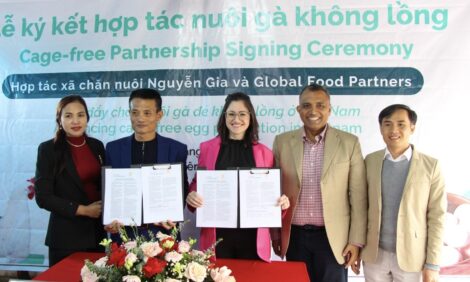



Researchers Present Progress on Poultry Disease Involving Reoviruses
Developments in our understanding of diseases caused by reoviruses were covered during one of the poultry sessions at the 150th Annual Convention of the American Veterinary Medical Association (AVMA) held in Chicago in July 2013. Reoviruses are involved in causing viral arthritis as well as respiratory and enteric diseases of chickens and turkeys.Case Report: Reovirus Tenosynovitis in Broilers
Reoviruses have been isolated from a variety of tissues in chickens associated with viral arthritis, respiratory disease and enteric disease. They are also found in clinically normal chickens.
Samuel P. Christenberry from Phibro Animal Health reported that reovirus was isolated in south Alabama and characterised from several broiler flocks experiencing lameness and poor performance.
This case report he presented at the meeting describes the clinical presentation and laboratory findings obtained from these broiler flocks.
Viruses Isolated from Broilers with Joint Problems
Samples tendons were collected from broiler flocks that exhibited enlargement of hock joints by Alejandro Banda from Mississippi State University. Viral isolation was carried out by inoculation of chicken embryo kidney cell cultures (CEKC).
Several samples induced cytopathogenic effect characteristic of avian adenovirus and reovirus in the inoculated CEKC cultures. The presence of avian reovirus and avian adenovirus were confirmed by PCR and RT-PCR amplifications, and by sequencing and phylogenetic studies.
The significance of these findings was commented upon at the meeting.
Clinical Presentation of the Emerging Reovirus Variants in Turkeys and Chickens
In the summer of 2011, turkey flocks in the upper Midwestern states of the United States began to develop clinical signs similar to viral arthritis in chickens.
In the fall of 2011 and early winter of 2012, broiler flocks began to develop a similar viral arthritis in the US and Canada.
In these cases the clinical signs included oedema and rupture of the digital flexor tendons and differed from rupture of the gastrocnemius tendon seen in classical reovirus viral arthritis, reported Marshall R. Putnam from Ceva Biomune.
In each clinical presentation, variant reoviruses were isolated that differ antigenically from conventional reovirus vaccines.
Pathogenicity and Control of Recent (2011-2012) Reovirus Isolates from Broiler and Turkey Flocks Presenting with Viral Arthritis and Tenosynovitis
Reovirus-associated arthritis and tenosynovitis is a disease condition that typically affects the major weight-bearing joints and tendons in the legs of meat-type chickens, according to John K. Rosenberger from Aviserve LLC.
He reported that recently (2011-2012), reovirus-associated viral arthritis cases have been diagnosed in large numbers of broiler and turkey flocks produced in different geographic locations throughout the United States and Canada.
Reoviruses isolated from the tendons and/or joints of affected flocks were characterised in terms of relative pathogenicity and ability to evade immunity induced by conventional viral arthritis vaccines.
The researchers found that the reovirus isolates characterised differed markedly in terms of their relative pathogenicity and ability to evade immunity resulting from vaccination with attenuated viral arthritis vaccines.
Characterisation of Recent (2011-2012) Reovirus Isolates from Broiler and Turkey Flocks Presenting with Viral Arthritis and Tenosynovitis Using in-vitro Antibody-Dependent Virus Neutralisation Assays
In a related study, Sandra C. Rosenberger from Aviserve LLC described how reoviruses isolated recently (2011-2012) from the tendons and/or joints of affected broiler and turkey flocks produced in different areas throughout the US were characterised using in-vitro antibody-dependent virus neutralisation assays.
The neutralisation assays were performed using multiple homologous and heterologous reovirus polyclonal anti-sera prepared in SPF leghorns.
Based on the assays, reovirus isolates from several geographic locations were found to be antigenically similar whereas other isolates were distinctly different.
All of the isolates characterised differed antigenically from commercially available conventional live and inactivated viral arthritis vaccine viruses.
Characterisation of Outer Capsid Protein Sequences for Viral Arthritis Reovirus Isolates and Relatedness to in-vitro Antibody Neutralisation Comparisons and Resistance to Cross Challenge Assessments
Also from AviServe LLC, Milos Markis explained that numerous reoviruses were isolated from tendons and joints of multiple US chicken and turkey flocks presenting with arthritis and tenosynovitis.
Reovirus pathogenicity and antigenic relatedness were ascertained for selected isolates.
His presentation described the characterisation of outer capsid protein sequences derived from multiple reovirus arthritis isolates and correlations with antigenic relatedness determined by in-vivo cross challenges and in-vitro antibody-dependent virus neutralisation assays.
Isolation and Characterisation of Novel Reoviruses from Clinical Cases of Tenosynovitis
Numerous clinical cases of tenosynovitis from commercial broilers were submitted to the Poultry Diagnostic and Research Center at the University of Georgia starting in December 2011, reported Holly S. Sellers.
Affected flocks ranged from three to eight weeks of age and came from multiple companies in several states.
Tendons from affected flocks were submitted for virus isolation and genotyping by RT-PCR and sequencing of the sigma C protein.
Reoviruses were isolated from the tendons in a majority of the cases submitted.
Phylogenetic analysis of the amino acid sequences from the field isolates revealed more than 50 per cent similarity to known vaccine strains. The field isolates were 99 per cent similar to each other and identified as Group 1 variant reoviruses.
Select field isolates were evaluated in a one-way virus neutralisation assay using S1133 antisera and found to have VN titres less than 4, indicating a lack of serological identity with S1133, suggesting that S1133 antibodies may not be sufficient in providing protection against challenge with the field isolates.
The pathogenicity of one of the representative field isolates was evaluated in day-of-hatch broilers and resulted in clinical disease.
Additional clinical cases have been submitted and a second genotype of reoviruses has been identified. This recent group is genetically distinct from the group 1 variant reoviruses and shares an 80 per cent amino acid similarity with commercial vaccine strains.
Cross neutralisation assays are in progress to determine the serological relatedness of this new group of reoviruses to vaccines and group 1 field isolates.
Progress on Characterisation of Recent Reovirus Isolates Associated with Runting-Stunting and Tenosynovitis Cases in Georgia
The aim of a study at Georgia Poultry Laboratory Network reported by Arun B. Kulkarni was to characterise the small genomic (S1) segment and the predicted sigma C protein (sC) sequences from several clinical cases of tenosynovitis (TS) and runting-stunting syndrome (RSS) in Georgia.
Minor outer capsid protein sC is responsible for initial attachment to host cells and for inducing reovirus-specific neutralising antibodies.
Three of the six isolates (GA/12274, GA/12297 and GA/12355) isolates showed more than 86 per cent amino acid identity with the previously identified reovirus isolated from RSS cases from Georgia in 2006. Amongst these, the latter two isolates also shared more than 87 per cent identity with the European isolate FR694197.
Interestingly, isolate GA/12355 derived from RSS affected 14-day-old broilers, was over 81 per cent identical to two turkey isolates from US.
Finally, isolates GA/12257 and GA/12298 did not share any amino acid identity with the isolates from the previously described cases of RSS or those from turkeys.
With regard to the isolates from TS cases, two (GA/12149 and GA/12279) of the three isolates also shared 81 per cent and 72 per cent identity, respectively, with turkey origin isolates. The third isolate (GA/12111) did not share any identity with the US isolates.
It is noteworthy that, none of the isolates from the present study shared more than 52 per cent identity with commonly used vaccine strains, S1133 or 1733.
November 2013









